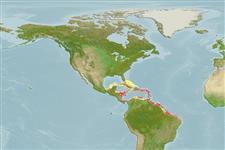Bivalvia |
Adapedonta |
Solenidae
Environment: milieu / climate zone / depth range / distribution range
Ecology
Benthic. Tropical
Western Atlantic: Caribbean to Brazil.
Length at first maturity / Size / Weight / Age
Maturity: Lm ? range ? - ? cmCommon length : 9.6 cm TL male/unsexed; (Ref. 344)
Shell very elongate (ratio length: width 5:1), dorsal and ventral margins parallel, hinge posterior, with single pair of cardinal teeth. Shell thicker at anterior margin. Umbones at the angle formed by dorsal and posterior margins. Colour: brown to purple.
Infaunal in muddy sand, in intertidal or shallow subtidal depths (Ref. 344).
Life cycle and mating behavior
Maturity | Reproduction | Spawning | Eggs | Fecundity | Larvae
Members of the class Bivalvia are mostly gonochoric, some are protandric hermaphrodites. Life cycle: Embryos develop into free-swimming trocophore larvae, succeeded by the bivalve veliger, resembling a miniature clam.
Leal, J.H. 2003 Bivalves. p. 25-98. In Carpenter, K.E. (ed.). The living marine resources of the Western Central Atlantic. Volume 1: Introduction, molluscs, crustaceans, hagfishes, sharks, batoid fishes, and chimaeras. FAO Species Identification Guide for Fishery Purposes and American Society of Ichthyologists and Herpetologists Special Publication No. 5. 1600p. (Ref. 344)
IUCN Red List Status
(Ref. 130435: Version 2025-1)
CITES status (Ref. 108899)
Not Evaluated
Not Evaluated
Threat to humans
Human uses
Fisheries: commercial
| FishSource |
Tools
More information
Trophic EcologyFood items (preys)
Diet composition
Food consumption
Predators
Population dynamicsGrowth
Max. ages / sizes
Length-weight rel.
Length-length rel.
Length-frequencies
Mass conversion
Abundance
Life cycleReproductionMaturityFecunditySpawningEggsEgg developmentLarvae PhysiologyOxygen consumption
Human RelatedStamps, coins, misc.
Internet sources
Estimates based on models
